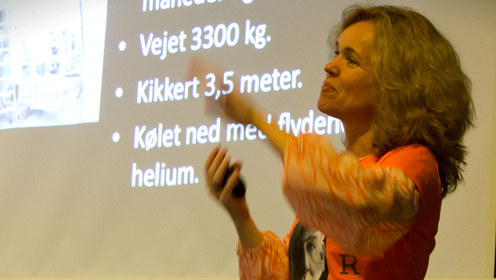Anja C. Andersen awarded the H.C. Ørsted Medal
Astrophysicist Anja Cetti Andersen is not just an accomplished researcher – she is also an excellent communicator. With her lively narrative style she is able to talk about space and astronomy so that everyone is captivated by the exciting research. In recognition of Anja Andersen’s unique ability to communicate about both astronomy and physics she has been awarded the H.C. Ørsted Medal in Silver. The medal is given out by Society for the Dissemination of Science in Denmark and will be presented by its patron, Her Majesty, Queen Margrethe.

With her lively narrative style Anja C. Andersen is able to talk about space and astronomy so that everyone is captivated by the exciting research.
Astrophysicist Anja Cetti Andersen is not just an accomplished researcher – she is also an excellent communicator. With her lively narrative style she is able to talk about space and astronomy so that everyone is captivated by the exciting research. In recognition of Anja Andersen’s unique ability to communicate about both astronomy and physics she has been awarded the H.C. Ørsted Medal in Silver. The medal is given out by Society for the Dissemination of Science in Denmark and will be presented by its patron, Her Majesty, Queen Margrethe.
Anja C. Andersen is an associate professor at the Niels Bohr Institute, where she researches dust in the universe and to make it less remote and scientifically abstract, she begins by comparing it with something we are all familiar with: dust in our homes. She explains that dust collects into dust bunnies that get bigger and bigger and eventually can become big balls of dust under the sofa and in the corners. And this is exactly what is happening in the universe, she explains. Cosmic dust accumulates and new stars and planets are formed. So the Earth is just a big ‘dust bunny’.
It is of course not that simple – dust in our homes and dust in the universe are two very different things, but everyone in the audience is smiling and listening intently, because Anja Andersen has created an image that we can all relate to and it arouses our curiosity to understand what is happening. When she then goes into the scientific explanations and talks about cosmic dust, which is made up of gases, elements and smoke particles that become denser and denser clouds that eventually clump together into a large ball of glowing gas – a new star surrounded by planets, everyone can follow along and understand the exciting research better.
Recognition of rare communication skills
In recognition of Anja Andersen’s rare ability to make difficult subject material living and captivating and to get across to many people by holding lectures, participating in radio and television programmes as an expert, writing popular science articles and books – including three children’s books, she has now been awarded the H.C. Ørsted Medal in Silver by the Society for the Dissemination of Science in Denmark. The Silver Medal is awarded for outstanding dissemination of exact science to broad circles.
“It is truly a great honour to receive this medal. I follow in the footsteps of a number of excellent communicators and recipients of the Silver Medal like the physicist and Mars researcher Jens Martin Knudsen, former rector of the University of Copenhagen, physics professor Ove Nathan and not the least H.C. Ørsted himself, who spent a significant portion of his time communicating,” explains Anja Andersen.
She had Jens Martin Knudsen as a teacher when she studied physics at the Niels Bohr Institute and she said he was a terrific teacher and a great role model. Even when he taught the most boring subjects, he could make them interesting and relevant. For example, when you had to learn to calculate the force needed to move an object up a slope, he used the example of a rover that had to drive up a slope on Mars. The theoretical calculation instantly became relevant. Jens Martin Knudsen received the H.C. Ørsted Medal in 2000.
The H.C. Ørsted Medal is named after the Danish physicist and chemist H.C. Ørsted, who founded the Society for the Dissemination of Science in Denmark in 1824, as it was near his heart to spread scientific knowledge. As a physicist, he was very interested in electricity and magnetism and in 1820 he demonstrated the unique discovery of electromagnetism.
Chasing light
“H.C. Ørsted’s discovery nearly 200 years ago is part of the foundation for modern astrophysics. His experiment showed how electricity and magnetism were linked. This led directly to the discovery that visible light, infrared light and ultraviolet radiation, as well as radio waves are all electromagnetic waves with different wavelengths. This discovery was fundamental for astronomy to flourish as a modern science,” explains Anja Andersen, who will give a lecture entitled ’Chasing light with Ørsted’ at the medal ceremony.
Anja Andersen explains that without light there would be no astronomy, astrophysics or cosmology. Our knowledge about the universe is carried to Earth by light on many wavelengths, which has given us knowledge about other planets, galaxies, black holes and the ‘Big Bang’. She explains how light from space has made it possible for us to understand the near and distant universe.
See also:
Contact
Anja Cetti Andersen, Professor, Dark Cosmology Centre, Niels Bohr Institute at the University of Copenhagen, Phone: +45 35 32 58 92 Mobile: +45 51 48 36 88 Email: anja@nbi.ku.dk
